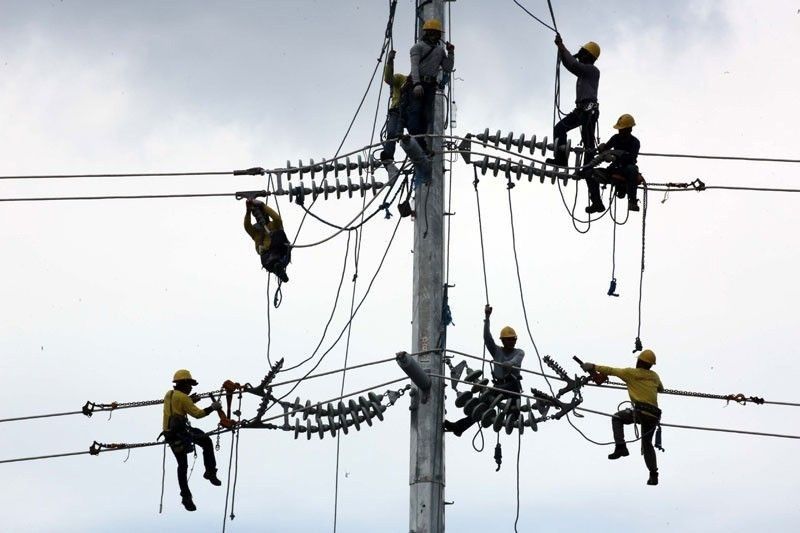Luzon may be on red alert until June 8

MANILA, Philippines — The Luzon grid is expected to experience power outages until next week after another power plant bogged down yesterday, causing rotational blackouts over prolonged hours.
The National Grid Corp. of the Philippines (NGCP) raised the red alert warning on the Luzon power grid from 10 a.m. to 5 p.m. and from 6 p.m. to 10 p.m. yesterday. The yellow alert notice was from 9 a.m. to 10 a.m., from 5 p.m. to 6 p.m. and from 11 p.m. to midnight.
A yellow alert means there were not enough reserves to cover the largest running generating unit at the time but does not necessarily lead to power outages. A red alert means there is severe power deficiency, which could lead to rotational power interruptions.
The NGCP said available capacity was at 11,408 megawatts (MW) while peak demand was projected to reach 11,593 MW.
The Department of Energy (DOE) said another power plant, the 316-MW GMEC Coal-Fired Power Plant Unit 2, shut down yesterday due to suspected boiler tube leak, which reduced electricity supply and led to insufficient power reserves in the power grid.
This increased the unavailable capacity on the power grid to 4,064 MW from 3,771 MW on Monday.
The DOE said it convened with representatives of the NGCP and GNPower Mariveles Energy Center (GMEC) to discuss the unplanned outage of GMEC Coal-Fired Power Plant Unit 2 since it is expected to be back online by June 8.
Because of this, the red alert status may be raised on the Luzon grid until next week or until the plants on forced outage restore operations.
“We foresee grid alert status until June 7,” NGCP head of Luzon System Operations Reynaldo Abadilla said at a press briefing.
The NGCP implemented manual load dropping (MLD) or rotational blackouts in parts of Luzon to maintain the integrity of the power system.
Manila Electric Co. (Meralco) also implemented rotational power interruptions within its franchise area starting at 1:05 p.m, with outage lasting up to two hours.
For the COVID vaccination centers and storage facilities, the NGCP said it is left with the distribution utilities (DUs) to come up with contingency measures, spokesperson Cynthia Alabanza said.
Meralco said locations of vaccination sites and storage facilities are spared from rotational power outages but are encouraged to maintain generators to provide backup supply.
The DOE called on the Energy Regulatory Commission (ERC) to look into these power outages and exercise its regulatory functions to ensure the continuity of power services during the pandemic.
“We are monitoring the situation. We are definitely looking into these outages and will take the necessary actions in accordance with existing laws,” ERC commissioner Floresinda Digal said.
Vaccine storage
Meanwhile, the Department of Health (DOH) assured the public yesterday that preparations have been made to protect COVID-19 vaccines amid the rotational brownouts in some parts of Luzon.
The DOH said contingency measures are in place to ensure the proper storage of COVID-19 vaccines.
The National Vaccination Operations Center ordered personnel of inoculation sites to ensure that the vaccines are kept in storage facilities, the DOH said.
With the measures in place, the DOH said the vaccines would remain in good condition.
The DOH noted that simulation activities have been conducted and that a backup power system is a requirement for local governments with cold storage facilities.
The Department of the Interior and Local Government (DILG) ordered
local government units (LGUs) to secure COVID-19 vaccines in their possession.
DILG spokesman Undersecretary Jonathan Malaya said the vaccines should be kept in cold storage facilities with uninterrupted power supply so that the jabs would not go to waste.
“At this time of pandemic, vaccines are more valuable than gold and
therefore contingency plans should be in place to mitigate the rotational power outages,” Malaya said.
He said LGUs should heed the red alert notice issued by the NGCP in parts of Luzon where blackouts will be implemented due to the increase in power demand caused by the humid weather.
Subsidized power rate
Meanwhile, Speaker Lord Allan Velasco commended President Duterte for signing into law a bill extending the “lifeline rate” or subsidized electricity rate for low-income households by 30 years.
“We thank President Duterte for ensuring that poor families will continue to enjoy the much-needed power subsidy for the next three decades,” Velasco, who previously chaired the House committee on energy, said.
The President signed Republic Act 11552 that amends the Electric Power Industry Reform Act (EPIRA) of 2011, under which the lifeline rate provision would expire on June 26.
The law extends for the second time the socialized pricing system for marginalized households under Section 73 of the original EPIRA law or RA 9136.
“This important legislation would assure Filipinos access to continuous and affordable electricity, especially during the COVID-19 pandemic where many people are struggling to make ends meet,” Velasco said.
He said around 5.5 million consumers, representing about 31 percent of the entire connections in the country, would benefit from the law. – Emmanuel Tupas, Mayen Jaymalin, Delon Porcalla, Cecille Suerte Felipe
- Latest
- Trending





























